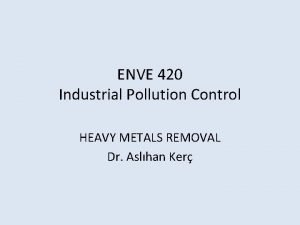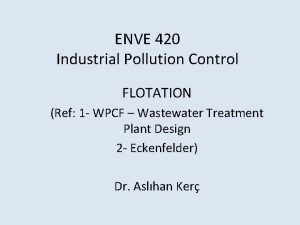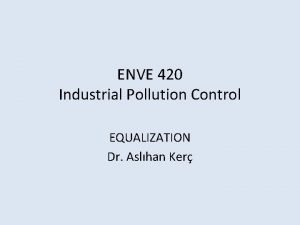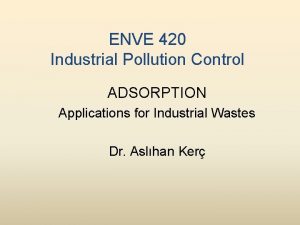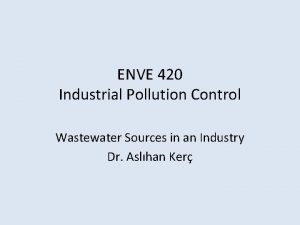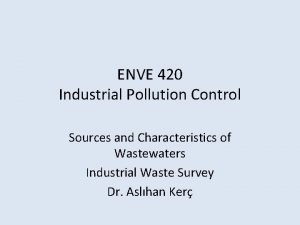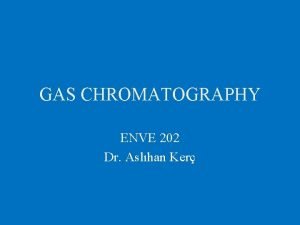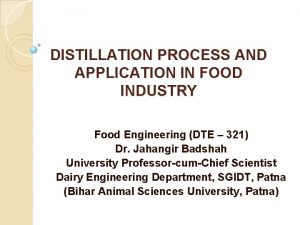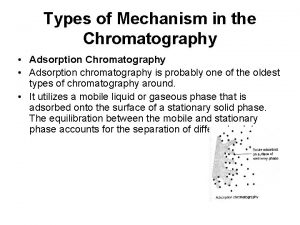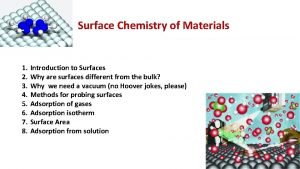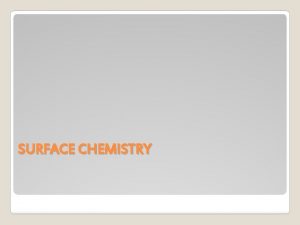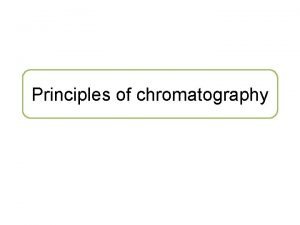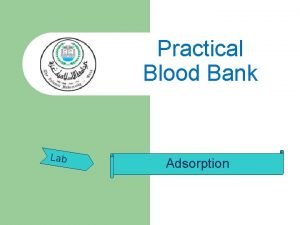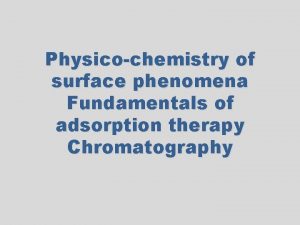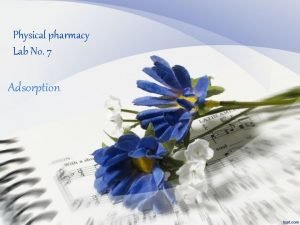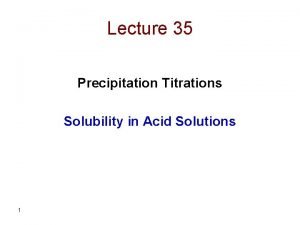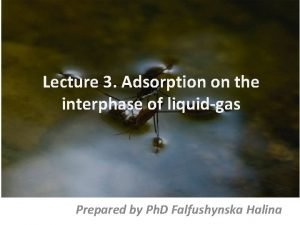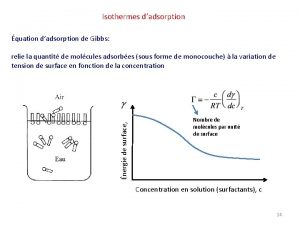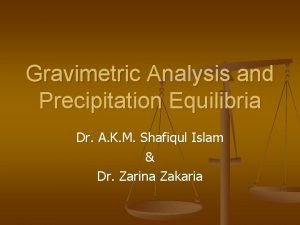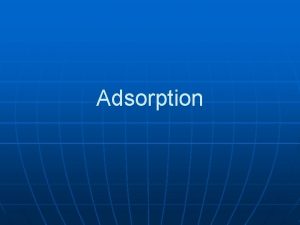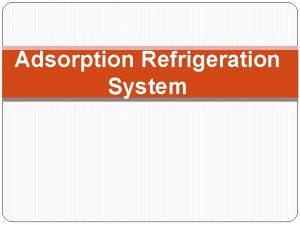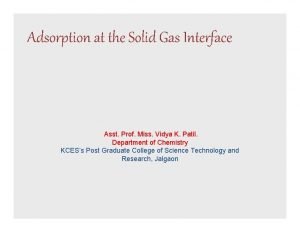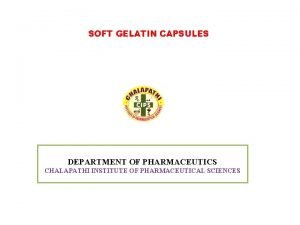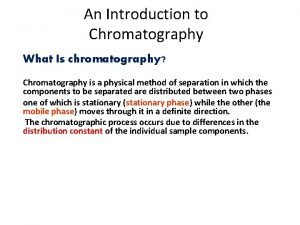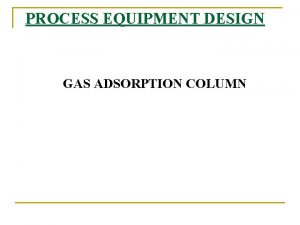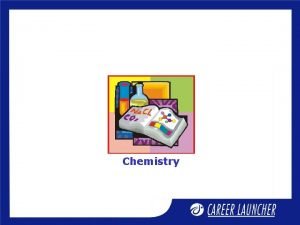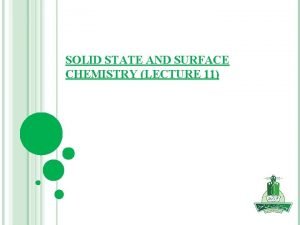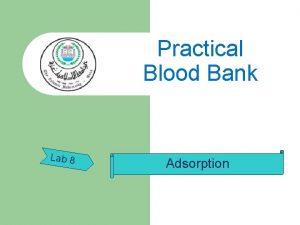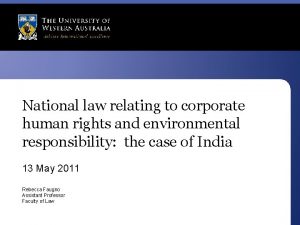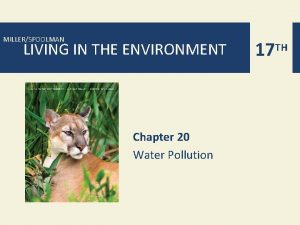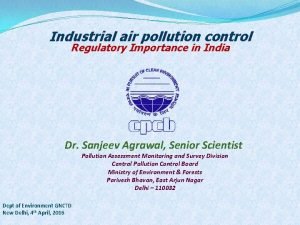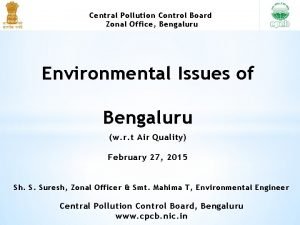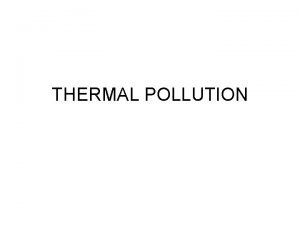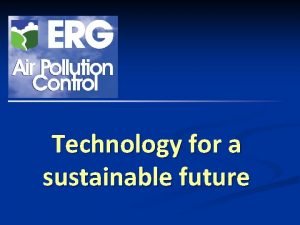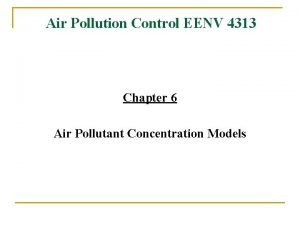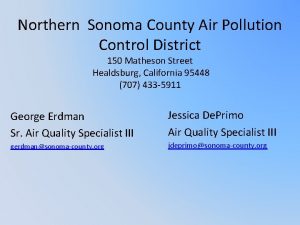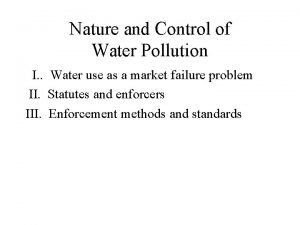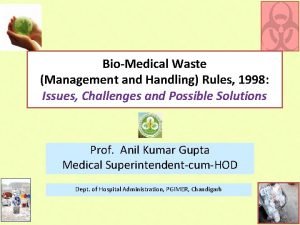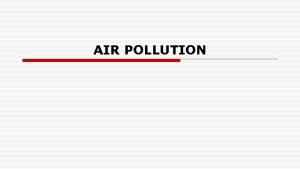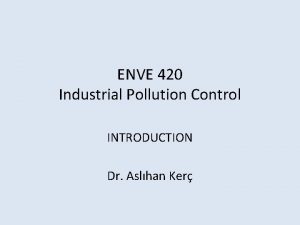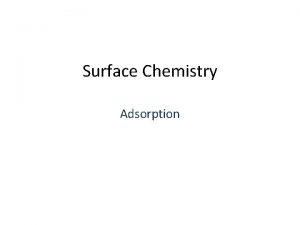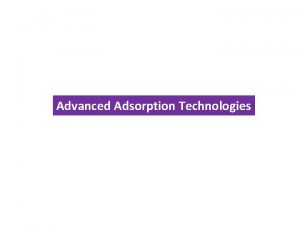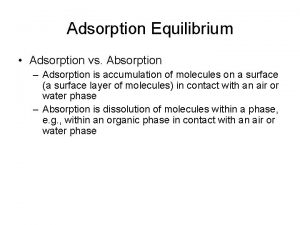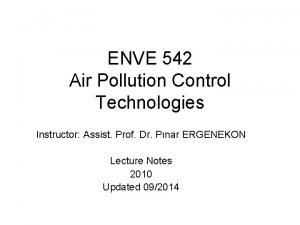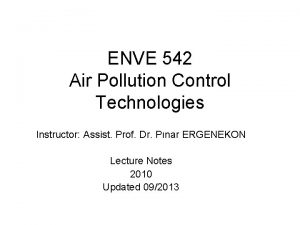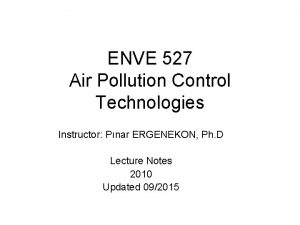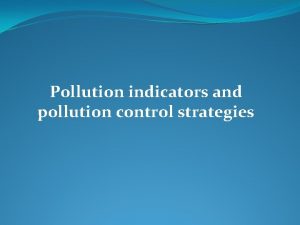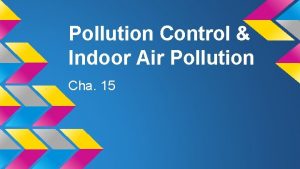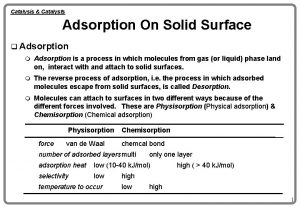ENVE 420 Industrial Pollution Control ADSORPTION Applications for













































- Slides: 45

ENVE 420 Industrial Pollution Control ADSORPTION Applications for Industrial Wastes Dr. Aslıhan Kerç

Adsorption Equilibrium • Adsorption vs. Absorption – Adsorption is accumulation / adhesion of molecules at the surface of a solid material (usually activated carbon) in contact with an air or water phase – Absorption is dissolution of molecules within a phase, e. g. , within an organic phase in contact with an air or water phase

Adsorption PHASE I ‘PHASE’ 2 Absorption (“partitioning”) PHASE I PHASE 2 Henry’s Law

The Jargon of Adsorption

Causes of Adsorption • Dislike of Water Phase – ‘Hydrophobicity’ • Attraction to the Sorbent Surface – van der Waals forces: physical attraction – electrostatic forces (surface charge interaction) – chemical forces (e. g. , - and hydrogen bonding)

Adsorption Phenomenon The surface of a solid shows a strong affinity for molecules that come into contact with it. Certain solid materials concentrate specific substances from a solution onto their surfaces. Adsorption Phenomenon Physical adsorption (physisorption): Physical attractive forces (van der Waals forces) e. g. Carbon ads, Activated alumina Chemical adsorption (chemisorption): the adsorbed molecules are held to the surface by covalent forces. (little application in ww treatment)

Adsorbents in Natural & Engineered Systems • Natural Systems – Sediments – Soils • Engineered Systems – Activated carbon – Metal oxides (iron and aluminum as coagulants) – Ion exchange resins – Biosolids

Engineered Systems - Removal Objectives • Activated carbon (chemical functional groups) – Adsorption of organics (esp. hydrophobic) – Chemical reduction of oxidants • Metal oxides (surface charge depends on p. H) – Adsorption of natural organic matter (NOM) – Adsorption of inorganics (both cations & anions) • Ion exchange resins – Cations and anions – Hardness removal (Ca 2+, Mg 2+) – Arsenic (various negatively charged species), NO 3 -, Ba 2+ removal

Activated Carbon Systems Carbon systems generally consist of vessels in which granular carbon is placed, forming a filter bed through which ww passes.

Activated Carbon Systems Area requirement: less If anaerobic conditions occur Biological activity in carbon beds H 2 S formation Spent Carbon land disposal problem, unless regenerated Regeneration systems Expensive + Air pollution problems

Activated Carbon

Activated Carbon Systems Pretreatment is important to reduce solids loading to granular C systems. Powdered Activated Carbon (PAC) can be fed to ww using chemical feed equipment.

Activated Carbon Systems Mostly used for organic matter removal. AC remove variety of organics from water (not selective) Metal removal: Recent applications in metal removal Few in full scale Pretreatment by sedimentation / filtration to remove precipitated metals Remaining dissolved metals adhere to the carbon until all available sites are exhausted. Spent carbon Replaced with new or regenerated C

Factors effecting Carbon Adsorption • Physical and chemical characteristics of carbon (surface area, pore size) • Physical and chemical characteristics of adsorbate ? (molecular size, molecular polarity, chemical composition) Higher molecular weight more easily adsorbed Molecular weight Size

Factors effecting Carbon Adsorption • Concentration of adsorbate in the liquid phase (solution) • Characteristics of the liquid phase ? (p. H, temperature) • Contact time • Increasing solubility of the solute in the liquid carrier decreases adsorbability • Branched chains are usually more adsorbable than straight chains

Factors effecting Carbon Adsorption • Substituent groups (hydroxyl, amino, carbonyl groups, double bonds) • Molecules with low polarity are more sorbable than highly polar ones.

Oxygen-Containing Surface Groups on Activated Carbon Mattson and Mark, Activated Carbon, Dekker, 1971

Steps in Preparation of Activated Carbon • Pyrolysis – heat in absence of oxygen to form graphitic char • Activation – expose to air or steam; partial oxidation forms oxygen-containing surface groups and lots of tiny pores

Properties of of Ativated Carbon Made from: (? ) - Wood - Lignin - Bituminous coal - Lignite - Petroleum residues Standards for specific applications: - Pore size - Surface area - Bulk density

Factors Affecting Activated Carbon Properties • Starting materials (e. g. , coal vs. wood based) and activation • Pores and pore size distributions • Internal surface area • Surface chemistry (esp. polarity) • Apparent density • Particle Size: Granular vs. Powdered (GAC vs. PAC)

Characteristics of Some Granular Activated Carbons Characteristics of Activated Carbons (Zimmer, 1988) F 300 H 71 C 25 Bituminous Coal Lignite Coconut Shell Bed Density, ρF (kg/m 3) 500 380 500 Particle Density, ρP (kg/m 3) 868 685 778 Particle Radius (mm) 0. 81 0. 90 0. 79 Surface Area BET (m 2/g) 875 670 930 0. 33 0. 21 0. 35 ---- 0. 38 0. 14 ---- 0. 58 0. 16 ---- 1. 17 0. 65 Activated Carbon Raw Material Pore Volume (cm 3/g) Micro- ( radius < 1 nm) Meso- (1 nm < r < 25 nm) Macro. Total (radius > 25 nm)

Other parameters used for AC characterization • Phenol Number: Index of carbon’s ability to remove taste and odor compouns • Iodine Number: Adsorption of lowmolecular weight substances Micropores, radius <2 µm • Molasses Number: Carbon’s ability to adsorb high molecular weight substances Pores 1 – 50 µm

Other parameters used for AC characterization High iodine number Effective for ww with low molecular weight organics High molases number Effective for ww with high molecular weight organics

Kinetics of Atrazine Sorption onto GAC

Carbon Regeneration Objective: Remove the previously adsorbed materials from the carbon pore structure Methods: - Thermal - Steam - Solvent extraction - Acid / base treatment - Chemical Oxidation

Thermal Regeneration Drying Desorption High temperature heat treatment (650 – 980 o. C) in the presence of water vapor, flue gas, oxygen - Multiple heat furnaces - Fluidized bed furnaces are used.

Adsorption Isotherms • Technical feasibility of Activated Carbon ↓ Adsorption tests ↓ Generate adsorption isotherms

Adsorption Isotherms • Technical feasibility of Activated Carbon ↓ Adsorption tests ↓ Generate adsorption isotherms

Adsorptive Equilibration in a Porous Adsorbent Pore Early Later Laminar Boundary Layer GAC Particle Adsorbed Molecule Diffusing Molecule Equilibrium

Adsorption Isotherms Add Same Initial Target Chemical Concentration, Cinit, in each Control Different activated carbon dosage, Csolid, in each An adsorption ‘isotherm’ is a q vs. c relationship at equilibrium

Metal Oxide Surfaces Coagulants form precipitates of Fe(OH)3 and Al(OH)3 which have –OH surface groups that can adsorb humics and many metals Humic substances where R is organic

Sorption of NOM on Metal Oxide

Sorption of Metals on Metal Oxide SOH + Me 2+ SOMe+ + H+

Ion Exchange Resins 2 R--Na+ + Ca 2+ R 2 -Ca + 2 Na+ R+-Cl- + H 2 As. O 4 - R+- H 2 As. O 4 - + Cl-


Assuming mineral surface started with q = 0: If mineral surface started with q >0:

Commonly Reported Adsorption Isotherms Linear: Langmuir: Freundlich:

Shape of Langmuir Isotherm

Shape of Freundlich Isotherm

Shape of Freundlich Isotherm (log scale)

Example. Adsorption of benzene onto activated carbon has been reported to obey the following Freundlich isotherm equation, where c is in mg/L and q is in mg/g: A solution at 25 o. C containing 0. 50 mg/L benzene is to be treated in a batch process to reduce the concentration to less than 0. 01 mg/L. The adsorbent is activated carbon with a specific surface area of 650 m 2/g. Compute the required activated carbon dose. Solution. The adsorption density of benzene in equilibrium with ceq of 0. 010 mg/L can be determined from the isotherm expression: A mass balance on the contaminant can then be written and solved for the activated carbon dose:

Example If the same adsorbent dose is used to treat a solution containing 0. 500 mg/L toluene, what will the equilibrium concentration and adsorption density be? The adsorption isotherm for toluene is: Solution. The mass balance on toluene is:

General Process Design Features • Contactors provide large surface area • Types of contactors – Continuous flow, slurry reactors – Batch slurry reactors (infrequently) – Continuous flow, packed bed reactors • Product water concentration may be – Steady state or – Unsteady state

Powdered Activated Carbon (PAC) PAC + Coagulants Settled Water Sludge Withdrawal PAC particles may or may not be equilibrated PAC + Coagulants Flocculated Water Process Operates at Steady-State, cout = constant in time

Packed Bed Adsorption v, c. IN Natural Packed Bed – subsurface with groundwater flow Engineered Packed Bed- granular activated carbon EBCT = empty-bed contact time (Vbed/Q) Adsorptive capacity is finite (fixed amount of adsorbent in bed) v, c. OUT Process operates at unsteady state, c. OUT must increase over time
 Enve420
Enve420 Envee 420
Envee 420 Enve 420
Enve 420 Enve 420
Enve 420 Envee 420
Envee 420 Envee 420
Envee 420 Enve 202
Enve 202 Separation process in food industry
Separation process in food industry Industrial applications of robots
Industrial applications of robots Adsorption chromatography types
Adsorption chromatography types Freundlich equation
Freundlich equation Positive and negative adsorption
Positive and negative adsorption Principles of chromatography
Principles of chromatography Adsorption technique in blood banking
Adsorption technique in blood banking Adsorption
Adsorption Adsorption of oxalic acid on charcoal lab experiment
Adsorption of oxalic acid on charcoal lab experiment Koettsdorfer number is also known as
Koettsdorfer number is also known as Chromatography mobile phase and stationary phase
Chromatography mobile phase and stationary phase Eosin adsorption indicator
Eosin adsorption indicator Freundlich adsorption isotherm formula
Freundlich adsorption isotherm formula Les types d'adsorption
Les types d'adsorption Von weimarn ratio
Von weimarn ratio Dry gum method and wet gum method
Dry gum method and wet gum method What is adsorption
What is adsorption Adsorption refrigeration cycle
Adsorption refrigeration cycle Solid gas interface
Solid gas interface Plate process of soft gelatin capsules
Plate process of soft gelatin capsules Adsorption introduction
Adsorption introduction Introduction chromatography
Introduction chromatography Process equipment design solved problems
Process equipment design solved problems Positive adsorption
Positive adsorption Langmuir adsorption isotherm
Langmuir adsorption isotherm Adsorption technique in blood banking
Adsorption technique in blood banking Central and state pollution control board
Central and state pollution control board Methods of water pollution
Methods of water pollution Slogans on air pollution
Slogans on air pollution Functions of pollution control board
Functions of pollution control board Energy chips in thermal pollution
Energy chips in thermal pollution Erg (air pollution control) ltd
Erg (air pollution control) ltd Control measures of noise pollution
Control measures of noise pollution Control measures of water pollution
Control measures of water pollution Fixed box model air pollution
Fixed box model air pollution Northern sonoma county air pollution control district
Northern sonoma county air pollution control district Site:slidetodoc.com
Site:slidetodoc.com Punjab pollution control board
Punjab pollution control board Air pollution control methods
Air pollution control methods
